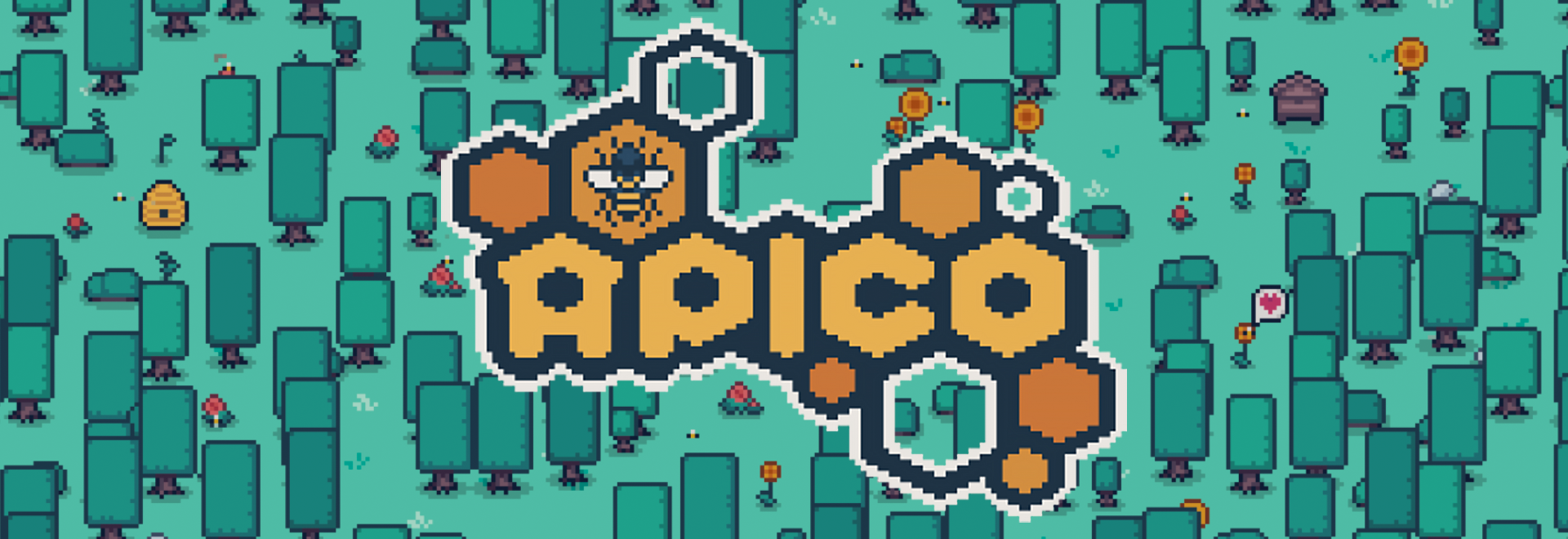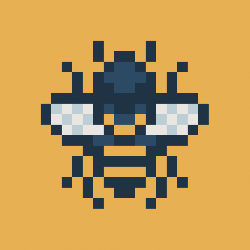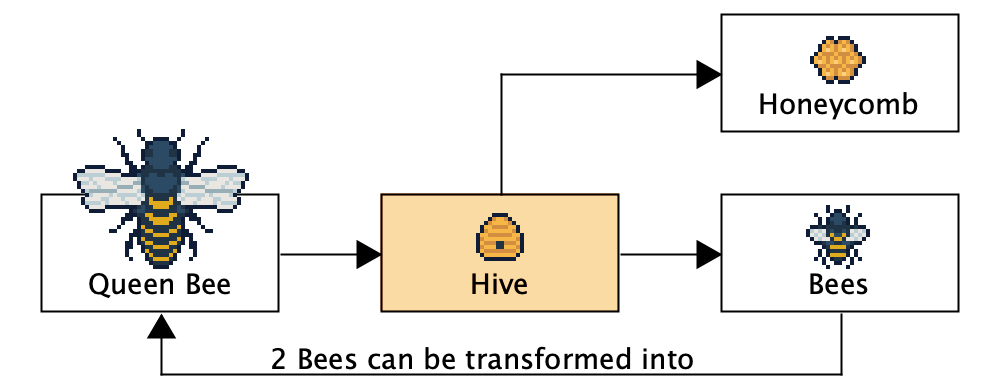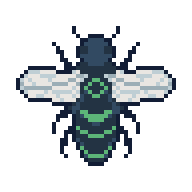Sustainable Gameplay Loops in Apico
Breaking the selfish farming loop for the sake of saving bees

Apico is a chill beekeeping sim about caring for and breeding bees to restore the environment and the world. The laid-back aspect of the game cannot be overstated. All of its mechanics are relaxing, and there is no need for a rush, even though some elements are time-based. The game also has no violent elements, which frees you from worrying about surviving.
While playing Apico, your only concern is to care for your bees and discover their mysteries.
On the surface level, one could compare the game's proposal to the likes of other famous farm sims, such as Stardew Valley, but Apico is gameplay-wise and game-design-wise quite its own thing. In other farm sims, farming is mainly done for self-orientated goals (like making money), whereas in Apico, the beekeeping mechanic is focused on altruistic environmental recovery. In other words, it is a game about a selfless process of (helping to) heal nature rather than personal growth and enrichment. That is a powerful stance but also a creatively challenging one.
In this piece, and in the spirit of the start of spring in the northern hemisphere, I'll discuss how Apico breaks the traditional formula of economy-focused games by using clever and creative game mechanics, gameplay loops, and education.

Gameplay Loop and Breeding Bees
We understand a Gameplay Loop as the cyclical and repetitive process in which the player performs throughout the entire game. Almost all games will have one or more gameplay loops, which are core to how we enjoy them.
For example, in a game of checkers, the gameplay loop involves each player selecting and moving their pieces on the board and then performing the consequences of the movement, such as taking another's player piece. In more complex games (i.e. with more rules and dynamics), there are often more gameplay loops happening simultaneously and others that are activated upon certain conditions.
Apico has a timed gameplay loop for breeding bees: a queen bee is placed in a hive, and after some time, it spawns other bees and some honeycomb.

As shown in the diagram above, the loop part happens as the output of the hive mechanism produces its very input. Two bees can be combined into a queen bee that can reactivate the hive and produce even more bees and honeycombs. This characteristic also makes this gameplay loop a feedback loop.
A feedback loop that generates more resources is a positive feedback loop. Positive feedback loops are often a source of game destabilization and must be kept attentive so as not to unbalance the experience quickly.
However, Apico's approach to feedback loops, and more broadly to gameplay loops, is one in which there are no concerns towards unbalancing since the result of the mechanisms is helpful to the environment. There are no consequences or harm from producing more bees. On the contrary, that is the very objective of the game: restoring the world's bee populations to self-sustainable levels.

Honey and Money
One of the byproducts of breeding bees is honeycomb which can be sold for money (0.2 rubee, to be more precise). It is undoubtedly not a reliable source of income compared to other more elaborate schemes in the game, but that is also an interesting aspect to be studied.
Contrary to other farm sims, money is far from an essential resource in this game. In fact, money works mainly as an intermediary resource to unlock other parts of the game, such as buying a boat from Skipper to reach other islands.
The most advanced equipment and functionalities are not even unlocked by money. Instead, they are acquired through other resources or by breeding special bees. This is different from other games in which money is always a vital resource.
Other games use different metals or magic elements as stepping stones instead. Consider the ore progression in Stardew Valley, composed of copper, silver, gold, and iridium. As the player gathers them, there is always a monetary component to be invested in upgrading the player's tools. Then money is not a stepping stone. It is always relevant and integral to the game's progression until the end.
But for Apico, one could argue that money is not even necessary at some point in the game and will quickly become a surplus. That helps to keep the game focused on its main loops of breeding and restoring bees.
Money still has some relevance, but besides being a stepping stone for the game's progression, it is also an important tool to guide and gather the player's interest in the game's teaching moments. As if by design, the player's attention towards money is used to lure them into other engaging domains of the game.
Consider, for instance, the gameplay loop for creating Apicola, a more reliable source of income. Apicola is the result of fermenting honey and water. The diagram below shows one way of getting honey in the game:

If you are unfamiliar with Apico, you might have been surprised by the number of steps required to get some delicious honey. First, you must use an Apiary instead of a common beehive. Apiaries hold frames that gather bee products. Frames have to be uncapped and then have their fillings extracted in an extractor.
The player acquires honey and bee products. The latter depends on the bee bred in the apiary. Honey is a liquid, a special type of resource in the game, and must be kept in containers such as barrels and canisters.
Now, if you think this process sounds similar to how honey is harvested in real life, then you are correct! Check how Doug the bee guy does it.
The honey-extracting mechanism generates resources with direct and indirect monetary value. However, notice that the player has to undergo quite an educational process to acquire those. You must learn to earn (pun intended).
The bee products produced in this process are part of many mechanics. Some of them, like the Beepollen, can be directly sold for rubees (1 rubee each). Thus, beepollen has direct monetary value. The Calidus, on the other hand, can be sold for rubees (2 rubees each) or used to infuse an apicola bottle increasing its value from 15 rubees to 20 rubees. That way, the calidus has both direct and indirect monetary values.
The amount of honey produced depends on the bee type used and the bee's productivity trait. Every bee has specific traits that control factors such as its lifespan, honey productivity, and fertility. The player must learn to work and manipulate traits via the game's genetic system to produce more honey. And yes, you guessed it, it is also based on real-life biology.

Trees, Flowers, and Sustainability
Indeed, Apico also has examples of traditional farm sim games, such as logging for wood and wood-related resources and mining for gathering stones and ore. Most of these are not sustainable without the player's action, such as replanting trees or generating rocks through other means than mining.
However, as happens with money, these resources are mostly stepping stones and are often used in non-monetary contexts. Wood, for example, is mainly used to make tools and workshops. Surely those will be part of the money-making processes, but the wood itself is not a big part once used.
Moreover, other mechanics require the player to actively participate in replating trees, such as gathering resin. In that, the game forces the player into keeping a sustainable playstyle to avoid running out of resources and getting stuck into a dead end (or deadlock, if you are familiar with more game economy terms).
Moreover, flowers are another engaging resource in the game, with a significant impact on the overall mechanics. Flowers have an area of effect around them that influence the bee traits and other characteristics.

Pondshine, for example, keeps non-nocturnal bees up a few more hours into the night. Beesknees, on the other hand, increase the bees' fertility by 1. Contrary to the pondshine, hivanium keeps nocturnal bees up a few more hours into the day. These traits can be active simultaneously, making the flower placement an essential part of the game's strategy.
Besides that, they naturally just make the environment more pleasing. They can be harvested to be part of some mechanisms, but a regular playthrough will have many growing everywhere.
That also ties back into the bee breeding mechanism. Bees will roam around their hives to interact with flowers. More types of flowers are discovered as bees cross-pollinate them. You guessed it correctly again, and this is also inspired by how bees act in real life and why they are so crucial for the environment.
With that also, we can see how all these mechanics to unlock new elements and special productions are tied back to the game's core: bee breeding. It is at the core of the game's loop and the main activity in which the other elements are activated. And even if some are meant to empower the player and diversify the resources or tools, the main objective is not player-focused; it is sustainable and environment-centric.

Lessons from the Hive
Overall, the main point in which Apico breaks from the traditional formula, which leads to its more creative and educational gameloops, is the subversion of the positive feedback loop. The player is free to keep breeding bees no matter what.
Other games impose many barriers, often monetary, to this cycle to hinder the player from reaching an unbalanced state. Consider, for example, another farm game in which the player can continuously harvest and sell crops. Quickly the surplus of income will render any challenges obsolete.
However, the goal in Apico is not a financial one. To restore all bees to nature, the player must explore the world, learn about genetics, and domesticate species to venture forth into breeding them back to sustainable levels. There is no concern about a lack of challenge because all challenges focus on the bee breeding cycle and its creative variations. It also avoids boredom since discovering new species is always slightly different and new.
Take the Vibrant Bee, for example. It is acquired by cross-breeding two types of bees in a specific daytime frame. Blocking the breeding process would instead interrupt the cycle of player experimentation towards successfully birthing their first vibrant bee.
Some veteran players might point out that once a bee is discovered, you can actually buy them from Barnabee, which is true, but they are pretty expensive. Moreover, if you remember the more reliable ways of making money, such as by selling apicola, you already figured out that the process involves breeding bees to produce honey. That already defeats the purpose of buying them out.
But it is also important to notice how Apico opposes some of its loops to nudge the player into its other elements and mechanics. For example, frames deteriorate with every use to counter the honey production positive feedback loop until they collapse and must be replaced with new ones. Apicola also needs to be bottled before it can be sold, which requires buying empty bottles from Skipper.

From that, we can outline the game design learnings from Apico in a few points:
- Unrestrained positive feedback loops can work as long as their cycles can be diversified to push the player towards other mechanics and mechanisms.
- If most resources act as stepping stones for progress, then unrestrained positive feedback loops have a smaller chance of trivializing the challenge.
- Educational processes can be fun if they are cohesive and meaningful within the gameplay and its elements.
Finally, as another outcome of these points, we can establish that strictly numerical challenges are inevitably bound to be exploited using other numerical schemes, such as power playing or theory-crafting. For example, if the game's objective can be solved by hoarding money, all money-related schemes can be optimized to increase player enrichment.
That is not necessarily an issue. Many players thrive and rejoice by crunching numbers and formulae in spreadsheets in search of the perfect strategy (I am very guilty of that). But Apico is good at proving that strategic and economy-based games do not need to restrict themselves to numerical endeavours. Other forms of challenge can equally amuse the players and create visionary experiences.
Explore different possibilities and break conventions for the sake of more diverse games. And, of course, save the bees :)
Thanks for reading 😊. You can join me here if you want to know more about me and my work.
